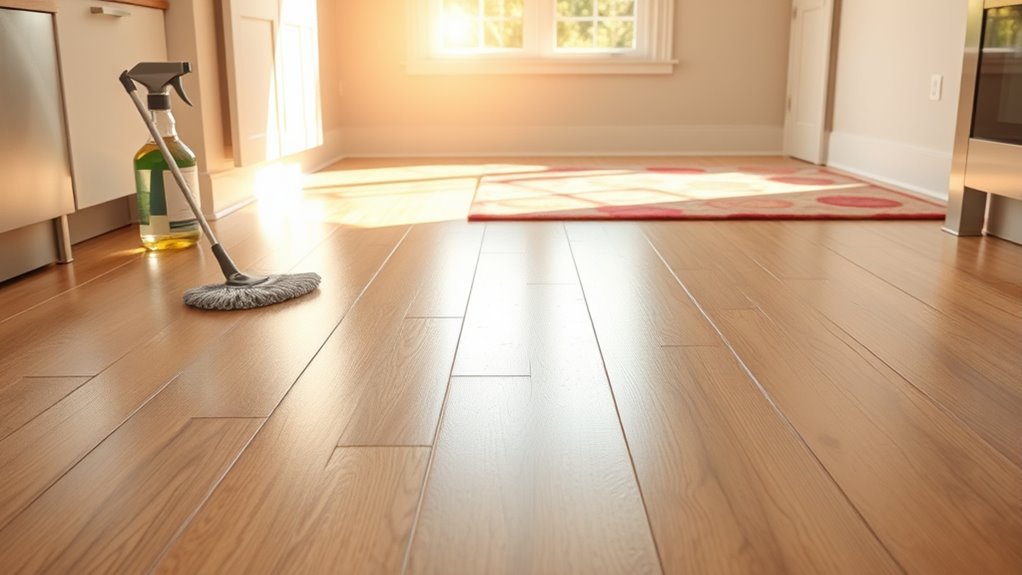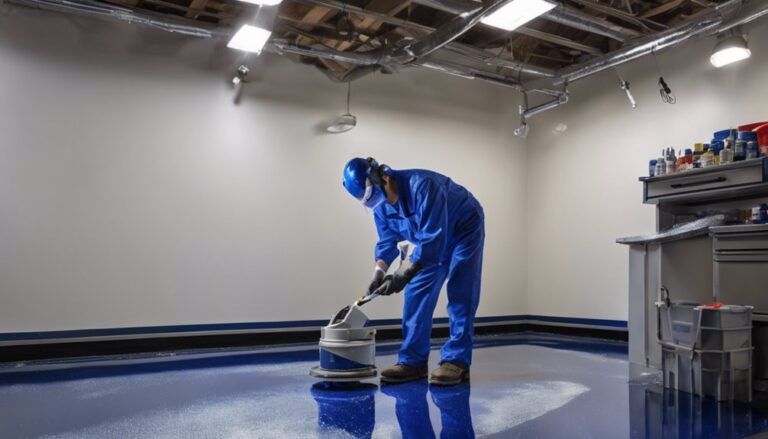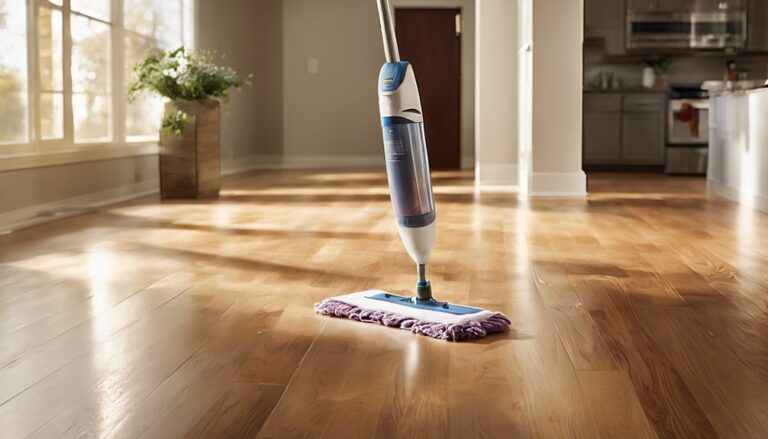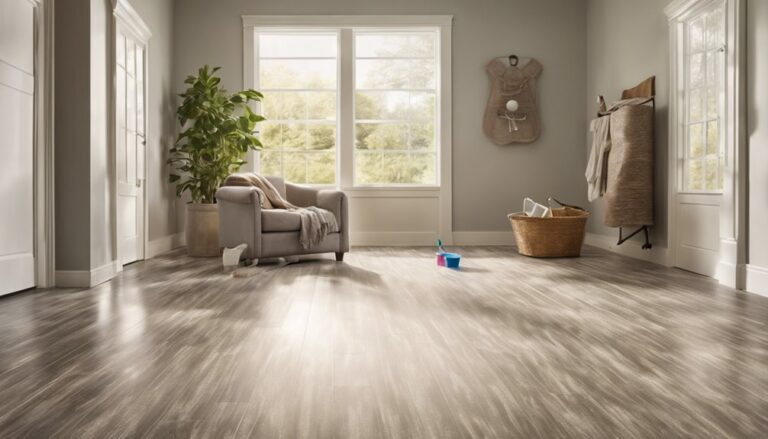To get rid of sticky floors, first identify the residue type like sugary spills or adhesive. Sweep and vacuum thoroughly to remove debris. Mop with warm soapy water to break down stickiness, then apply a vinegar-water solution on stubborn spots for extra lift. For tougher films, use a baking soda paste or rubbing alcohol carefully. Rinse well and dry completely to prevent streaks. Maintaining regular cleaning habits will keep stickiness away—explore deeper steps to restore your floor’s smooth finish.
Identify the Cause of Stickiness
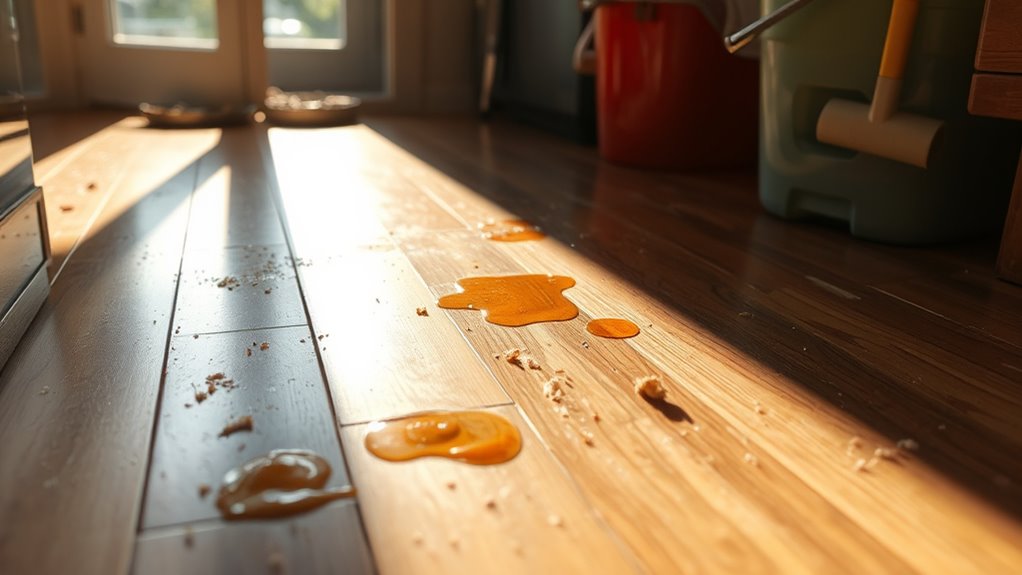
Before you can effectively clean sticky floors, you need to pinpoint what’s causing the stickiness. Start by examining the type of sticky substances present—spilled sugary drinks, adhesive residues, or dirt buildup can all leave different residues. Consider the floor materials as well: vinyl, hardwood, tile, or laminate each react differently to cleaning methods. Identifying the exact cause helps you choose the right approach, preventing damage and saving time. For instance, sugary residues require thorough rinsing, while adhesive may need a solvent safe for your floor. Don’t overlook environmental factors like humidity or old cleaning product buildup, which can contribute to stickiness. By understanding both the sticky substances and your floor materials, you gain control over the problem and move closer to a clean, free-from-stickiness floor.
Gather Essential Cleaning Supplies
Knowing what’s causing the stickiness and understanding your floor type sets the stage for choosing the right cleaning supplies. To tackle sticky floors effectively, gather essential tools that align with your vloeren material and the nature of the residue. Having the right cleaning supplies at hand guarantees a smooth, efficient process and frees you from repeated attempts.
Here are the essential tools you’ll need:
- Microfiber mop or soft-bristle broom
- Bucket for mixing cleaning solutions
- pH-neutral floor cleaner or mild detergent
- Warm water for dilution and rinsing
- Soft cloths or sponges for spot cleaning
With these cleaning supplies, you’re equipped to restore your floor’s freedom from stickiness, maintaining its appearance without damage or residue.
Sweep and Vacuum the Floor Thoroughly
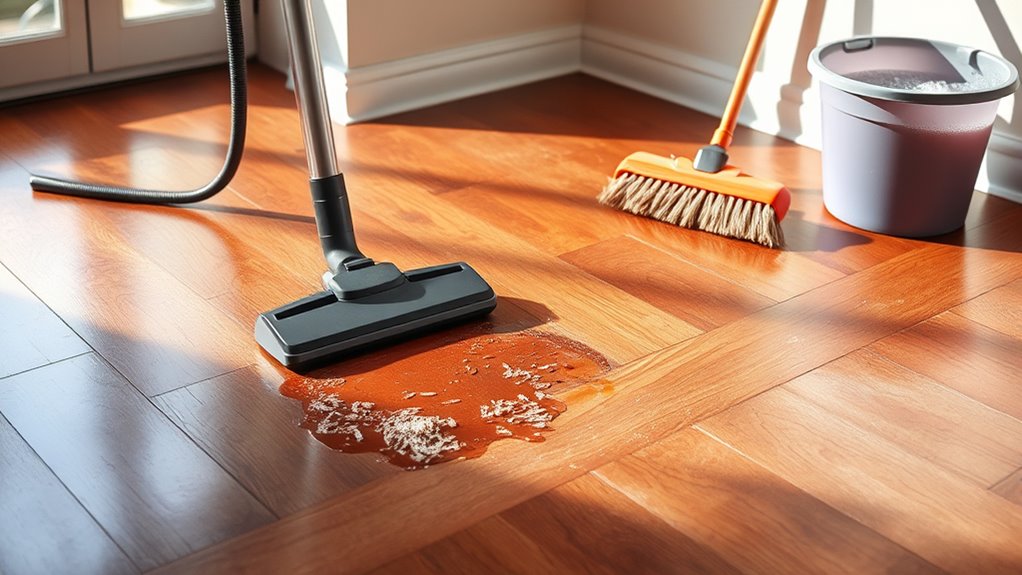
Start by using a broom designed for your floor type to sweep away loose dirt and debris efficiently. Don’t forget to vacuum along corners and edges where dust tends to accumulate. This thorough cleaning will prevent grit from sticking and guarantee your floor is ready for deeper cleaning.
Use Proper Sweeping Tools
One of the most effective ways to tackle sticky floors is by using the right sweeping tools to remove dirt and debris thoroughly. Choosing tools tailored to your floor materials guarantees you don’t scratch or damage surfaces while mastering sweeping techniques. Here’s what you should consider:
- Soft-bristle broom for hardwood and laminate floors
- Stiff-bristle broom for tile or concrete
- Microfiber dust mop for fine dust and pet hair
- Adjustable broom handles to reduce strain and improve control
- Compact handheld broom for corners and tight spots
Using these tools methodically lets you clear away grime that causes stickiness, freeing your floor from buildup. When you match your tools to your floor materials, sweeping becomes more efficient, helping you maintain a clean, sticky-free surface with ease.
Vacuum Corners and Edges
After sweeping with the right tools, don’t overlook the corners and edges where dirt often hides. Effective corner cleaning is essential to eliminate sticky residues that accumulate unnoticed. Use a vacuum with specialized attachments to reach tight spaces and remove dust and debris trapped along baseboards and floor edges. Edge maintenance prevents buildup that regular sweeping misses, ensuring your floor feels consistently clean and smooth underfoot. Focus on methodically vacuuming each corner and edge, moving slowly to lift grime rather than pushing it deeper. This step not only improves your floor’s appearance but also prepares it for any mopping or treatment you’ll apply next. Consistent corner cleaning and edge maintenance keep sticky floors from recurring, granting you the freedom of a truly clean, comfortable space.
Use Warm Soapy Water for Initial Cleaning
A single bucket of warm soapy water is your best tool for breaking down the sticky residue on your floors. Start by mixing a mild soap with warm water, creating an effective soap mixture that loosens grime without damaging surfaces. This initial cleaning step sets the stage for a stick-free floor.
When using your warm water and soap mixture, remember to:
- Use a soft mop or cloth for gentle scrubbing
- Change the water when it gets dirty to avoid spreading residue
- Focus on small sections to control cleaning
- Rinse the mop frequently in the warm water
- Avoid soaking the floor to prevent water damage
This method gives you control and freedom from sticky messes, restoring smooth, clean floors quickly.
Apply Vinegar Solution for Sticky Residue
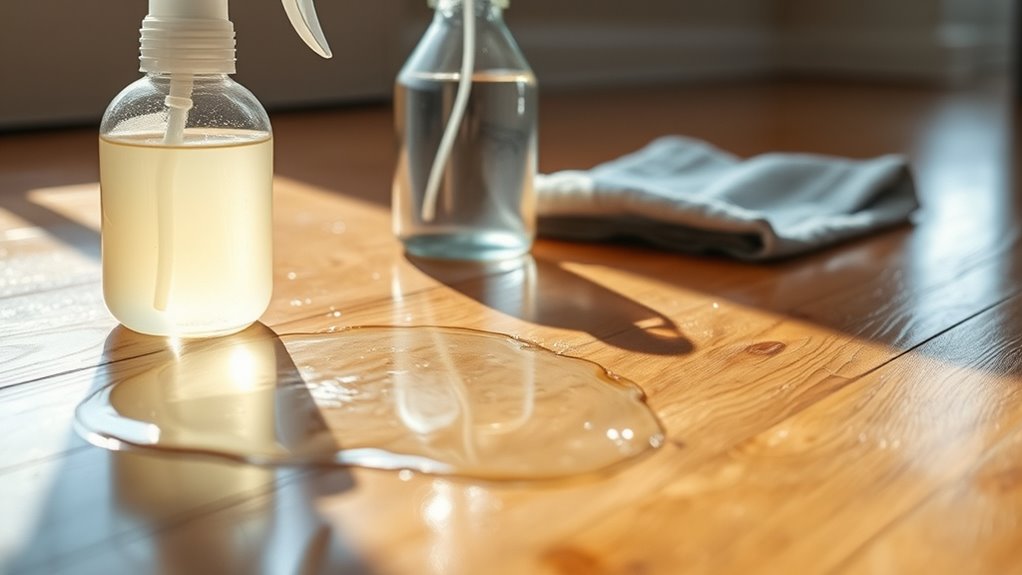
If warm soapy water hasn’t fully removed the stickiness, applying a vinegar solution can break down stubborn residues effectively. Vinegar benefits your cleaning routine by cutting through grime and sticky buildup without harsh chemicals. Mix equal parts white vinegar and water in a spray bottle for an efficient cleaning technique. Spray the solution onto the sticky floor areas, let it sit for 5 minutes to dissolve residue, then scrub gently with a microfiber cloth or soft brush. Avoid soaking the floor; excessive moisture can damage certain surfaces. Finally, wipe the area with a clean damp cloth to remove any vinegar smell and residue. This method restores your floor’s natural feel while providing a safe, eco-friendly way to eliminate stickiness, giving you freedom from persistent messes.
Try Baking Soda Paste for Tough Spots
Tackle tough sticky spots by applying a baking soda paste, which acts as a gentle abrasive to lift residue without damaging your floor. This method gives you control over problem areas, freeing you from stubborn grime. To use it effectively:
- Mix baking soda with a small amount of water to form a thick paste
- Apply the paste directly to tough spots on the floor
- Let it sit for 5-10 minutes to break down sticky buildup
- Gently scrub with a soft cloth or sponge in circular motions
- Wipe clean with a damp cloth, then dry thoroughly
This straightforward approach targets sticky floors without harsh chemicals, preserving your floor’s finish while restoring its freedom from residue.
Clean With Rubbing Alcohol for Sticky Film
You can effectively remove sticky film by cleaning your floor with rubbing alcohol, which dissolves residue without damaging surfaces. Apply it using a cloth or spray bottle, working in small sections to prevent streaks. Make certain the area is well-ventilated and test a small spot first to verify compatibility with your flooring.
Benefits of Rubbing Alcohol
Although sticky floors can be stubborn, rubbing alcohol offers a quick and effective solution for removing the sticky film without leaving residue. Its unique properties make it an ideal choice for tackling tough grime while preserving your floor’s finish. Understanding the rubbing alcohol benefits empowers you to clean confidently and efficiently.
Here are key advantages of using rubbing alcohol:
- Evaporates quickly, preventing moisture damage
- Dissolves sticky residues with minimal effort
- Leaves no oily or sticky residue behind
- Acts as a mild disinfectant for added hygiene
- Safe on most hard floor surfaces when used properly
Application Tips and Tricks
How exactly should rubbing alcohol be applied to remove sticky film effectively? Start by selecting a rubbing alcohol concentration of 70% or higher for robust cleaning power. Test a small, inconspicuous area first to verify compatibility with your floor materials, especially on sensitive surfaces like hardwood or vinyl. Dampen a clean cloth with rubbing alcohol—don’t soak it—and gently rub the sticky spots using circular motions. Avoid puddling the alcohol, as excess moisture can damage certain floor materials. For stubborn residue, let the alcohol sit for a minute before wiping. Afterward, wipe the area with a damp cloth to remove any leftover residue and dry thoroughly. These cleaning techniques guarantee efficient removal of sticky film while preserving your floor’s integrity, giving you freedom from sticky messes with confidence.
Rinse and Dry the Floor Properly
Once the sticky residue has been loosened or removed, it’s crucial to rinse the floor thoroughly to eliminate any leftover cleaning agents that could attract dirt or cause slipperiness. Mastering effective rinse techniques guarantees your floor stays clean without residue. Use clean water and a mop or sponge, changing water frequently to prevent re-depositing dirt.
For drying methods, consider these tips to avoid streaks and moisture damage:
- Use a dry microfiber mop or towel to absorb excess water
- Open windows or use fans to speed up drying
- Avoid walking on the floor until fully dry
- Use a squeegee for smooth surfaces to remove water efficiently
- Confirm corners and edges are not missed during drying
These steps free you from sticky floors and keep surfaces safe and spotless.
Prevent Future Stickiness With Regular Maintenance
To keep your floors from becoming sticky again, you’ll need to stick to a consistent cleaning routine that targets dirt and spills before they build up. Regular cleaning is essential for effective floor maintenance, preventing grime and residue that cause stickiness. Use a mild detergent and warm water to mop floors weekly, and address spills immediately to avoid stubborn stains. Incorporate a dry mop or microfiber cloth to capture dust and debris daily. Periodically, deep clean with a suitable floor cleaner based on your floor type to remove buildup invisible to the eye. By committing to this methodical floor maintenance schedule, you’ll preserve your floors’ cleanliness and smooth texture, giving you more freedom from sticky messes and time spent on repairs.

